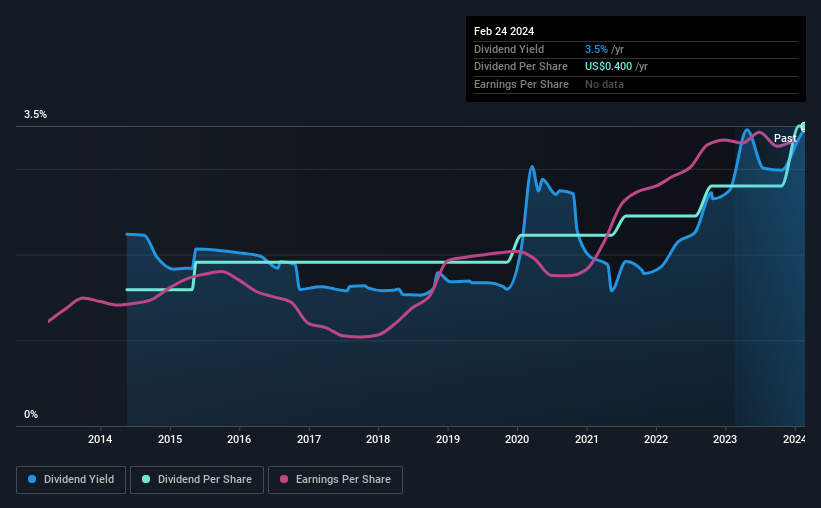Bank of the James Financial Group, Inc. (NASDAQ:BOTJ) Passed Our Checks, And It's About To Pay A US$0.10 Dividend
Readers hoping to buy Bank of the James Financial Group, Inc. (NASDAQ:BOTJ) for its dividend will need to make their move shortly, as the stock is about to trade ex-dividend. Typically, the ex-dividend date is one business day before the record date which is the date on which a company determines the shareholders eligible to receive a dividend. It is important to be aware of the ex-dividend date because any trade on the stock needs to have been settled on or before the record date. In other words, investors can purchase Bank of the James Financial Group's shares before the 29th of February in order to be eligible for the dividend, which will be paid on the 15th of March.
The company's next dividend payment will be US$0.10 per share, on the back of last year when the company paid a total of US$0.40 to shareholders. Calculating the last year's worth of payments shows that Bank of the James Financial Group has a trailing yield of 3.5% on the current share price of US$11.50. If you buy this business for its dividend, you should have an idea of whether Bank of the James Financial Group's dividend is reliable and sustainable. So we need to investigate whether Bank of the James Financial Group can afford its dividend, and if the dividend could grow.
Check out our latest analysis for Bank of the James Financial Group
Dividends are typically paid from company earnings. If a company pays more in dividends than it earned in profit, then the dividend could be unsustainable. Bank of the James Financial Group has a low and conservative payout ratio of just 17% of its income after tax.
Generally speaking, the lower a company's payout ratios, the more resilient its dividend usually is.
Have Earnings And Dividends Been Growing?
Businesses with strong growth prospects usually make the best dividend payers, because it's easier to grow dividends when earnings per share are improving. If earnings decline and the company is forced to cut its dividend, investors could watch the value of their investment go up in smoke. For this reason, we're glad to see Bank of the James Financial Group's earnings per share have risen 12% per annum over the last five years.
Many investors will assess a company's dividend performance by evaluating how much the dividend payments have changed over time. Since the start of our data, 10 years ago, Bank of the James Financial Group has lifted its dividend by approximately 8.2% a year on average. We're glad to see dividends rising alongside earnings over a number of years, which may be a sign the company intends to share the growth with shareholders.
Final Takeaway
Is Bank of the James Financial Group an attractive dividend stock, or better left on the shelf? Typically, companies that are growing rapidly and paying out a low fraction of earnings are keeping the profits for reinvestment in the business. Perhaps even more importantly - this can sometimes signal management is focused on the long term future of the business. In summary, Bank of the James Financial Group appears to have some promise as a dividend stock, and we'd suggest taking a closer look at it.
On that note, you'll want to research what risks Bank of the James Financial Group is facing. Our analysis shows 1 warning sign for Bank of the James Financial Group and you should be aware of this before buying any shares.
A common investing mistake is buying the first interesting stock you see. Here you can find a full list of high-yield dividend stocks.
Have feedback on this article? Concerned about the content? Get in touch with us directly. Alternatively, email editorial-team (at) simplywallst.com.
This article by Simply Wall St is general in nature. We provide commentary based on historical data and analyst forecasts only using an unbiased methodology and our articles are not intended to be financial advice. It does not constitute a recommendation to buy or sell any stock, and does not take account of your objectives, or your financial situation. We aim to bring you long-term focused analysis driven by fundamental data. Note that our analysis may not factor in the latest price-sensitive company announcements or qualitative material. Simply Wall St has no position in any stocks mentioned.

